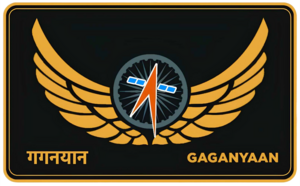This article may require copy editing for grammar, style, cohesion, tone, or spelling. (March 2024) |
 Indian Astronaut Patch | |
| Program overview | |
|---|---|
| Country | India |
| Organization | Human Space Flight Centre (ISRO) |
| Purpose | Human spaceflight |
| Status | Active |
| Programme history | |
| Cost | ₹10,000 crore (US$1.2 billion) for maiden crewed mission |
| Duration | 2006–present[1]
|
| First flight | Gaganyaan-1 (2024)[2] |
| First crewed flight | Gaganyaan-4 (NET 2025)[3] |
| Launch site(s) | Satish Dhawan Space Centre |
| Vehicle information | |
| Launch vehicle(s) |
|
The Human Rated Launch Vehicle (or Gaganyaan) is an ongoing programme by the Indian Space Research Organisation (ISRO) to develop the technology needed to launch crewed orbital spacecraft into low Earth orbit.[4] Three uncrewed flights, named Gaganyaan-1, Gaganyaan-2 and Gaganyaan-3 are scheduled to launch in 2024, followed by crewed flight in 2024 on an HLVM3 rocket.[3][2][5][6][7]
Before the Gaganyaan mission announcement in August 2018, human spaceflight was not a priority for ISRO, but it had been working on related technologies since 2007,[8] and it performed a Crew Module Atmospheric Re-entry Experiment[9] and a Pad Abort Test for the mission.[10][11] In December 2018, the government approved a further ₹100 billion (US$1.5 billion) for a 7-days crewed flight of 2–3 astronauts.[12][13][14][15]
If completed successfully, India will become the fourth nation to conduct independent human spaceflight after the Soviet Union/Russia, United States, and China. After conducting the first crewed spaceflights, the agency intends to start a space station programme, crewed lunar landings, and crewed interplanetary missions in the long term.[16][17]
- ^ "Scientists Discuss Indian Manned Space Mission". Archived from the original on 13 April 2021. Retrieved 13 January 2020.
- ^ a b "Gaganyaan launch delayed: Manned mission now in 'fourth quarter of 2024'". Times of India. 21 December 2022. Retrieved 15 February 2023.
- ^ a b "Prime Minister reviews readiness of Gaganyaan Mission".
- ^ "Gaganyan: How to send an Indian into space". 16 August 2018.
- ^ Ramesh, Sandhya (4 December 2022). "India's first human spaceflight Gaganyan in limbo, astronauts partially trained, ISRO silent". ThePrint. Retrieved 6 December 2022.
- ^ Kumar, Chethan (22 July 2021). "Gaganyaan 1st uncrewed mission unlikely before June 2022; no life support systems testing". The Times of India. Retrieved 23 July 2021.
- ^ "First human-rated test flight for India's Gaganyaan not likely in 2021". The Tribune. 1 July 2021. Archived from the original on 29 October 2021. Retrieved 1 July 2021.
- ^ Cite error: The named reference
plwas invoked but never defined (see the help page). - ^ "Crew module Atmospheric Re-entry Experiment (CARE) - ISRO". Archived from the original on 16 August 2022. Retrieved 19 September 2022.
- ^ "Satellites Are Our Priority Now, Not Human Space Flight". Outlook. Retrieved 21 July 2017.
- ^ "ISRO's first 'pad abort' test, critical for future human space mission, successful". The Hindu. 5 July 2018.
- ^ "Indian Astronaut Will Be in Space For 7 Days, Confirms ISRO Chairman".
- ^ Singh, Surendra (29 December 2018). "Rs 10,000 crore plan to send 3 Indians to space by 2022". The Times of India. Retrieved 29 December 2018.
- ^ Indians To Spend 7 Days In Space In Rs. 10,000 Crore Gaganyaan Plan: 10 Points, NDTV, 28 December 2018.
- ^ Suresh, Haripriya (15 August 2018). "JFK in 1961, Modi in 2018: PM announces 'Indian in space by 2022,' but is ISRO ready?". The News Minute.
- ^ "India eying an indigenous station in space". The Hindu Business Line. 13 June 2019. Retrieved 13 June 2019.
- ^ Cite error: The named reference
HTSep20was invoked but never defined (see the help page).